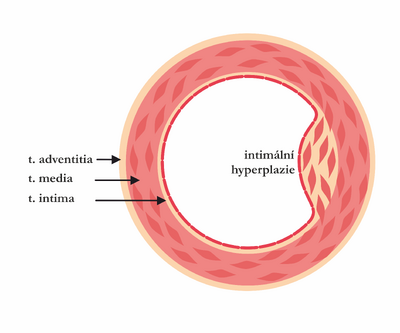Intimal hyperplasia
Intimal hyperplasia is a universal reaction of the vascular wall to its damage. When the endothelium is injured , there is a physiological local reaction, release of inflammatory mediators , aggregation of platelets , influx of fibrin and leukocytes , which support the migration of smooth muscle cells from the media to the intima with the help of growth factors . Muscle cells here proliferate and create an extracellular matrix, thus completing the healing process. The result is the formation of neo-intimacy in the area of injury. The problem, however, is that this excessive healing processit leads to local thickening of the intima that extends into the lumen of the vessel and causes stenosis.
Intimal hyperplasia is the " nightmare " of interventional radiologists and vascular surgeons, as it is responsible for the formation of stenoses and restenoses, after endovascular and surgical treatment. Intimal proliferation is additionally enhanced and accelerated by the presence of foreign materials (in-stent restenosis). It often arises not only after interventional and surgical interventions , but also at the site of a long-term inserted venous catheter , turbulent flow , at the sites of vascular anastomoses and grafts . Restenosis can appear in just a few months .
We can influence the reduction of the risk of intimal hyperplasia by being careful during procedures , by trying to minimize damage to the endothelium in and around the treated area, and by properly indicated use of stents and vascular prostheses.
Stenoses caused by intimal hyperplasia are very difficult to treat . When they dilate , further tissue damage occurs and thus new proliferation. The use of stents will help maintain the patency of the vessel, but itself promotes further hyperplasia . The tissue grows through the slits of the stents, in the case of coated stents, gradual obliteration occurs at their ends. Different treatment strategies for these restenoses are being investigated , e.g. drug- eluting balloons ( DEB ), drug-eluting stents (DES ), intravascular brachytherapy, systemic use of LMWH or warfarin.
Pseudointimal hyperplasia[edit | edit source]
In addition to intimal hyperplasia, there is the term pseudointimal hyperplasia , which refers to a similar event, which does not take place in the vessel wall, but in the intraparenchymal part of the liver after TIPS . The tissue that covers the stent in the intraparenchymal part of the liver is called pseudointima (fibrous layer continuously covered by endothelium). If its thickness exceeds 1000 μm, it is described as pseudointimal hyperplasia , which is involved in late TIPS dysfunction .
Links[edit | edit source]
Related Articles[edit | edit source]
Resources[edit | edit source]
- D´SOUZA, Donna, et al. Intimal hyperplasia [online]. Radiopaedia, [cit. 2014-03-27]. <https://radiopaedia.org/articles/intimal-hyperplasia>.
- JIRKOVSKÝ, Václav, et al. Dysfunkce transjugulární intrahepatální portosystémové spojky (TIPS) a její řešení : Přehledný referát [online]. Vnitřní lékařství, ©2007. [cit. 2014-03-27]. <https://www.prolekare.cz/pdf?ida=vl_07_02_10.pdf>.
- CURA, Marco, et al. Vascular and Interventional Radiology Review : Causes of TIPS Dysfunction [online]. American Roentgen Ray Society, ©2008. [cit. 2014-03-27]. <http://www.ajronline.org/action/cookieAbsent>.


